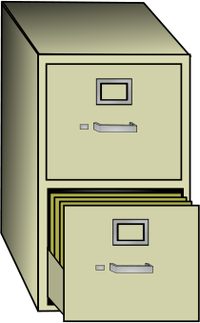Filesystem
(→Format details) |
Dan Tobias (Talk | contribs) (→Single-system filesystems) |
||
| Line 58: | Line 58: | ||
* [[POHMELFS]] (distributed Linux filesystem) | * [[POHMELFS]] (distributed Linux filesystem) | ||
* [[PRAMFS]] (Persistent & Protected RAM File-System) | * [[PRAMFS]] (Persistent & Protected RAM File-System) | ||
| − | * [[ProDOS file system]] (Apple) | + | * [[ProDOS file system]] (Apple II) (also used in Apple III SOS) |
* [[QFS]] | * [[QFS]] | ||
* [[ReFS]] (Microsoft's new FS- Resilient Filesystem, on Windows 8 Server) | * [[ReFS]] (Microsoft's new FS- Resilient Filesystem, on Windows 8 Server) | ||
| Line 65: | Line 65: | ||
* [[SDFS]] (Deduplication based filesystem) | * [[SDFS]] (Deduplication based filesystem) | ||
* [[SkyFS]] (SkyOS) | * [[SkyFS]] (SkyOS) | ||
| − | |||
* [[squashfs]] | * [[squashfs]] | ||
* [[UCSD p-System Filesystem]] (UCSD Pascal) | * [[UCSD p-System Filesystem]] (UCSD Pascal) | ||
Revision as of 02:09, 18 February 2014
Filesystems are Electronic Formats that are a prerequisite to being able to read any file off a digital medium — you have to be able to mount the filesystem, and thus read it, in order to be able to read a file.
Contents |
Single-system filesystems
(How files are organized on one system or device, such as a disk, tape, or flash memory; see next category for networked and cloud filesystems. Of course, any filesystem can be made available on a network to remote devices, but these are the native filesystems present on the storage device itself.)
- +D filesystem (Sinclair, SAM Coupé)
- Acer Fast Filesystem (SCO OpenServer)
- ADFS (Acorn MOS, RISC OS)
- AdvFS(Advanced File System, Digital/Tru64 Unix)
- Ami File Safe (Amiga)
- APF Imagination Machine disk file system
- Apple DOS file system (Apple II; see also ProDOS below)
- Atari File Management Subsystem (FMS: Atari 400/800)
- AthFS (AtheOS/Syllable)
- BFS (BeOS)
- btrfs (Linux)
- CBMFS (Commodore 64, PET, etc.)
- Compucolor file system
- CP/M file system
- cramfs
- DDFS (Data Domain File System)
- DTFS (Desktop File System, SCO OpenServer)
- EFS (Extent File System, SGI IRIX. Replaced by XFS)
- EOS file system (Coleco Adam "data pack" tape drives and disks)
- exFAT (Microsoft, for flash memory)
- ext (developed for Linux, previously used MINIX fs)
- ext2, ext3, ext4 (these are all just variants of each other)
- F2FS, (Flash Friendly Filesystem)
- FAT8
- FAT12
- FAT16
- FAT32
- FFS (Amiga Fast File System)
- Files-11 (VMS)
- Fossil (Plan 9)
- fuse-exFAT (open-source clone of exFAT)
- HAMMER (DragonflyBSD)
- HFS (MacOS)
- HFS+
- HPFS (OS/2 native file system)
- ISO 9660
- JFFS2
- LanyFS (Lanyard Filesystem)
- LogFS
- MDR (audio instrument format close to MSDOS)
- MFS (ancient Macintosh filesystem)
- MINIX file system
- NILFS2
- NTFS
- POHMELFS (distributed Linux filesystem)
- PRAMFS (Persistent & Protected RAM File-System)
- ProDOS file system (Apple II) (also used in Apple III SOS)
- QFS
- ReFS (Microsoft's new FS- Resilient Filesystem, on Windows 8 Server)
- ReiserFS
- SDFS (Deduplication based filesystem)
- SkyFS (SkyOS)
- squashfs
- UCSD p-System Filesystem (UCSD Pascal)
- UDF
- UFS (Unix Files System, Solaris and BSD)
- VMUFAT (Filesystem for Dreamcast VMU units)
- VSAM (Virtual Storage Access Method)
- VxFS (VERITAS File System)
- WAFL (NetApp's commercial file system)
- Xiafs (Linux, dropped in favour of ext2)
- XFS (SGI)
- XtreemFS, (Linux, distributed file system)
- YAFFS
- ZFS
Networked and cloud filesystems
(Used to make files available to multiple systems over a local or wide area network, including "on the cloud" via the Internet; systems access files through a protocol or API. The low-level storage details, usually concealed from end users and even most developers, may be within one or more of the single-device filesystems above, and the networked/cloud filesystem is generally defined independently of such details and might have very different characteristics and rules as to how the files are named, addressed, and structured.)
- Amazon S3
- Andrew File System (Carnegie Mellon University)
- Google Drive
- Google File System
- Hadoop Distributed File System
- MEGA file system
- NetWare File System (Novell NetWare, replaced by NSS)
- NSS (Novell Storage Services)
- OpenStack Swift
- SMB (Server Message Block, a protocol for a networked filesystem)
Format details
- AppleDouble
- Apple Partition Map
- AppleSingle
- desktop.ini (Windows)
- Desktop Services Store (Mac OS X)
- MBR (Master Boot Record)
- Resource Fork (MacOS)
- TRANS.TBL
